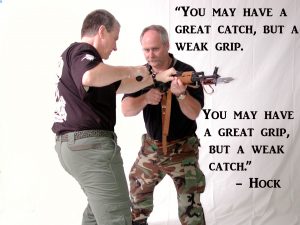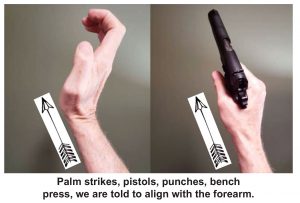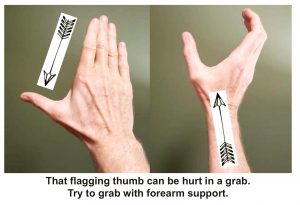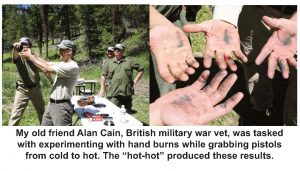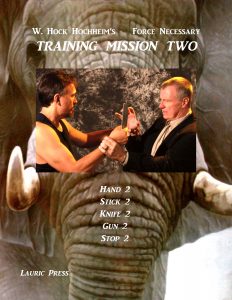A death grip is officially defined as an extremely tight grip, First you have to grab. One of my training structures is the Stop 6 program – the 6 common stopping points-collisions of a typical fight (or arrest). Stop 2 covers the hand, stick, knife, gun grabs on fingers, hands, wrists, and weapons. And importantly, their counters-escapes.
The grab is made of two components in Stop 2. The Death Grip is really about two parts :
- 1: the catch and,
- 2: the subsequent grip of your opponent’s lower arm, wrist, hand and weapon itself. You might have a great catch but a weak grip. You might have a tremendous grip but a weak catch.
In all of the Stops, 2 through 6, a+- catch and grip is not a catch or grip without your thumb. Your life depends on this, especially with a knife and pistol, all defined in the Stop 6 program.
All martial and even various sports training requires much catching skills and hand gripping strength as you can muster and exercises that directly or indirectly increase such are vital. Almost all people immediately get this idea.
“If your grips fail, all your technique goes out of the window. It becomes hard to execute anything.” – BJJ Coach Lawrence Griffith
All people get this? Well, not all. Decades ago, various, yet small group of famous martial artists would suggest not using your thumb in a capture of an opponent’s limb. I stood in numerous seminars in the 1980s and 1990s hearing some martial instructors say this. Their small point usually being that your thumb or hand could be caught in some kind of lock and you would be supporting that capture with your full grip. As one famous JKD guy use to say,
“Rule of thumb? Don’t use your thumb.”
Huh? At first I mindlessly accepted that. But when I gave it a mere second thought? No. The bigger point? Minutes later when trying to stop and grip a stick or knife attack, I watched these same instructors all unconsciously demonstrate full hand grabs the wrist or forearm. They fully grabbed limbs (and clothes) 99% of the time.
I would see in seminars, mine and others, an unchallenged, playful catch or stop with just a curved hand, with the thumb beside the fingers…among friends. NO! Now, this no-thumb-helping move stops almost nothing and an attacker can move but an inch and instantly swoop under the curved hand to hit, stab or shoot. The thumb grip stopped this.
Today, once in a while, I still hear this advice echoed around the world. They are down-line lineage from these people and it takes a little “slap to the brain” to shake them out of it. Not using your thumb to grab is a thinking disorder mistake. When doing throws and takedowns you use your full grip. In ground fighting you use your full grip.
And through the years I have run across self defense instructors who proclaim that fights never start with arm/wrist grabs. These short-sighted people have a tendency to view fights as bar fights, I think and are not schooled in the world of crime. They make fun of old school jujitsu and other systems that tend to start their programs with escapes from “common” grabs. BUT! CRIMES on the other hand, (no pun intended) like kidnappings, rapes, robberies, home invasions, assaults to murder entails such grabs. Victims are grabbed, pulled and pushed around. Tied up and taped. Handcuffed. And grabbing motions are also like weapon draw and drawn weapon interruptions.
Back in Training Mission One and in all the courses, I list the four ways a human limb attacks you, hand, stick or knife…
- 1: A thrusting motion.
- 2: A hooking motion.
- (Delivered either as a-)
- 3: A hit and retract, or…
- 4: A committed lunge.
It will always be hard to catch a thrust or hook, sure, but all kinds of untrained and trained people do in crimes and fights. But more importantly, look at the last two. The hit and retract and committed lunge. The hit and retract is a natural counter to a grab as it snaps back, and very difficult to seize. We have drills for that. While at times the committed lunge is caught and then driven foolishly into your catch-grip, actually helping your catch-grip.
Some notes on the Catch and Subsequent Grip
- Size. Be aware of the size of your hand in comparison to the limbs of others. (We police have many stories about this as we have had to arm wrestle people into cuffs.)
- Alignment. In the pistol shooting world and unarmed striking experts tell us to align with the forearm as much as possible. The palm strike, when thrusting, is called the palm heel strike because it can align with the forearm. In karate and various striking systems, they tell us to align the top two knuckles with the forearm. Folks suggest getting a pistol grip that aligns with the forearm, even though we can’t always shoot that way. In an Army gym decades ago, a power lifter told me to bench press using the bar on my palm heels as much as possible. You push a car with your palm heel, not your fingers.
It is a good idea to practice for that sort of alignment with a catch, to save your thumb from hyper-extensions and worse. Other steps like this are accomplished in sports and you can can develop this movement too. We have drills for this.
- Firearms. The topic of grabbing a long gun or pistol comes up and deserves an entire chapter. Any such photo of a firearm grab usually draws a comment of a too-hot-to-handle barrel. You have to be shooting a lot to make a common long gun or pistol a scorcher to the touch. Depends on the weapon. Think about the circumstances of you, who, what, when, where, how and why, defending yourself against a weapon that was run so long that it gets to hot to maintain a death grip on to save your life. Plus, there are so many circumstances, like a street crime, a robbery, a threat-only, a prisoner escort, an interrupted guard-sentry on duty, where the weapon is cold, or “warm,” that the subject must be discussed. I think an emergency grab of a pistol or long gun must be attempted at times and many of those times, the gun is not as hot as a flame torch. (How many modern troops today wear gloves anyway?)
Further in, as in Stops 3 through 6, there are arm wrap catches (even leg catches, but this is about Stop 2 problems, just a bit further out than 3, 4, 5 and 6. In Stop 2 segments we cover the hand, the stick, the knife and the gun, catch and grab. And their counters-escapes!
Need we list all the exercises for grip strength here in this short essay? I hope not because so many exercises develop it. Just search around. Oh and rule of thumb? Use your thumb. Wisely.
Contact Hock at HockHochheim@ForceNecessary.com
****************
Training Mission Two now available in downloads. Hardcover and paperback coming by Fall 2021. Click here

